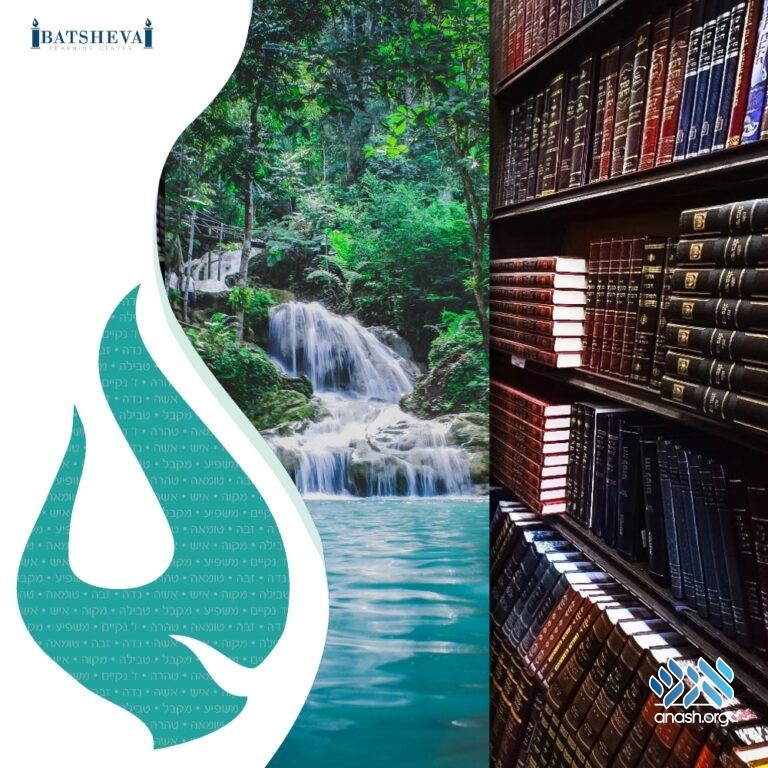Galvanized by positive reviews on their previous course, the Batsheva Learning Center is running an Insights into Hilchos Tahara course this spring in three cities — New York, Chicago, and L.A., — and online as well.
Meet Gavi Groberman: a preschool director from Seattle, Washington. After Gavi got engaged a couple of years ago, she learned all of hilchos tahara in six compact classes crammed in amidst the whirlwind of her wedding preparations. As a newlywed putting what she was taught into practice, she craved a deeper understanding of the halachos she was implementing into her life. When she heard about Batsheva Learning Center’s “Insights into Hilchos Tahara” course, it sounded like just what she was looking for.
She wasn’t disappointed.
Over the course of eight weeks, she was given the opportunity to delve into to the primary sources underlying hilchos tahara: first tracing the development of halachos from the pessukim in the Chumash, through the Gemara and Rishonim, and culminating with a study of its inner dimension through the lens of a maamar of the Rebbe Rashab and a reshima of the Rebbe. “The text-based learning was a refreshing challenge,” Gavi said of her experience. “The course gave me a newfound appreciation for this very special mitzvah.”
Next, meet Nechama Slonim: a campus shlucha at Rice University in Houston. Nechama finds learning Torah an especially powerful and enriching experience, both personally and spiritually. She’s especially drawn to text-based study. Intrigued by an advertisement for the Batsheva Learning Center Tahara course, she decided to make the time in her busy schedule to attend. In the process, Nechama discovered not only a unique learning opportunity, but a whole new side to the halachos she’d been practicing for years.
“It was so empowering to learn more about a mitzva I live with on a constant basis,” says Nechama. “Understanding it’s background gave me a new appreciation for the way the halachos are practiced today. And the ma’amar we learned gave me a deeper perspective on the elements of the mitzva I never resonated with before.”
Gavi and Nechama are just two of the students from the Batsheva Learning Center course that ran in the spring of 2020. Over fifty women across the U.S. participated in both in-person and online classes, making it the Batsheva’s most popular course to date. The group was a mix of married, single, and engaged women; those of all ages and stages could resonate with the ideas.
The material course didn’t overlap with what is taught in the typical kallah class or taharas hamishpacha refresher course. Rather than deal with the day-to-day practicals of taharas hamishpacha, it gave more of a birds-eye view of its halachlc and mystical underpinnings. Many felt that the course transformed not just their understanding of hilchos tahara, but of the halachic process, in general.
As Shterny Tubul put it: “Before taking the ‘Insights into Hilchos Tahara Course’, I thought I understood how Torah Sheba’al Peh worked. But I got so much clarity when I read the sources inside from the Rambam. It really explained how we get to the halachos we practice today and the authority of mitzvos drabanan.”
“Getting to learn the reasoning behind the complicated halachos of taharas hamishpacha gave me an appreciation for all of the day-to-day halachos we keep,” said Raizy Leitner. “It made me realize there are no random details; the halachos we keep are the culmination of an intricate, exacting, two-thousand year old process.”
Galvanized by the positive reviews, and wanting to bring this valuable information to yet more women, Batsheva Learning Center is running this course again this spring. The eight-week course will be offered in three cities — New York, Chicago, and L.A., — and online as well, accessible to women all over the world.
Each once a week, two-hour class will start with a chavrusa session, where students will get a chance to delve into the primary source texts, followed by a teacher-led group discussion on the material learned. This text-based format exposes the student to the richness of the material in the original and provides a space for building independent skills for learning these foundational texts.
The course comes endorsed by leading seminary and kallah teachers. Mrs. Rivky Kaplan of Tzfas describes the course as “a unique opportunity to learn halacha, particularly an area so relevant to Jewish women, in an in-depth, textual way… It leaves the student with a sense of ownership and empowerment. This is how learning is meant to be.”
In the words of Mrs. Sarah Morozow: “Batsheva Learning Center is filling a need by providing young women with the resources to learn text-based Torah in depth, both Nigleh and Chassidus. The Rebbe ziy”a encouraged women to learn Torah in a comprehensive fashion (see the sichah to women in Toras Menachem pgs. 171-175)… Batsheva Learning Center takes the utmost precautions to ensure that those studying this course will not, in any way whatsoever, be led to the conclusion that this study can chas v’shaIom replace the need to learn the halachos properly as they are delineated in the contemporary sefarim, as well to be in direct contact with a Rov. One who comes with yiras Shamayim and a thirst for in-depth Torah study will gain extensive knowledge about Taharas Hamishpacha, one of the three foundations of the Jewish home.”
For more information about the upcoming course, and to sign up, check it out at BatshevaLearningCenter.com/courses

Discussion
We appreciate your feedback. If you have any additional information to contribute to this article, it will be added below.